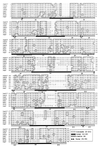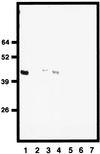Identification and characterization of a new porin gene of Klebsiella pneumoniae: its role in beta-lactam antibiotic resistance
- PMID: 10217760
- PMCID: PMC93711
- DOI: 10.1128/JB.181.9.2726-2732.1999
Identification and characterization of a new porin gene of Klebsiella pneumoniae: its role in beta-lactam antibiotic resistance
Abstract
Klebsiella pneumoniae porin genes were analyzed to detect mutations accounting for the porin deficiency observed in many beta-lactam-resistant strains. PCR and Southern blot analysis revealed the existence of a third porin gene in addition to the OmpK36 and OmpK35 porin genes previously described. This new porin gene was designated ompK37 and is present in all of the clinical isolates tested. The OmpK37 porin gene was cloned, sequenced, and overexpressed in Escherichia coli. In contrast to that of the major porins, OmpK37 porin expression was only detectable by Western blot analysis in porin-deficient beta-lactam-resistant strains, suggesting strong down regulation under standard laboratory conditions. Functional characterization suggested a narrower pore for the OmpK37 porin than for K. pneumoniae porins OmpK36 and OmpK35. This correlated with the susceptibility to certain beta-lactam antibiotics, since a K. pneumoniae strain expressing porin OmpK37, but not porin OmpK36 or OmpK35, was less susceptible to beta-lactam antibiotics than the same strain expressing either porin OmpK36 or OmpK35.
Figures




References
-
- Aggeler R, Then R L, Ghosh R. Reduced expression of outer-membrane proteins in β-lactam-resistant mutants of Enterobacter cloacae. J Gen Microbiol. 1987;133:3383–3392. - PubMed
-
- Ausubel F M, Brent R, Kingston R E, Moore D D, Seidman J G, Smith J A, Struhl K. Current protocols in molecular biology. New York, N.Y: Greene Publishing and Wiley Interscience; 1997.
Publication types
MeSH terms
Substances
Associated data
- Actions
LinkOut - more resources
Full Text Sources
Molecular Biology Databases

